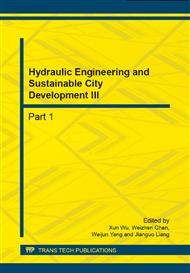p.191
p.196
p.201
p.205
p.209
p.217
p.222
p.226
p.232
Study on the Adsorptive Solute Cr(VI) Loss from Soil to Surface Runoff with Temkin Adsorption
Abstract:
Based on the water balance and solute mass conservation, a simple two-layer incomplete mixing model by Tong et al. (2009) is used to study adsorptive solute of Cr (VI) loss from soil into surface runoff with nonlinear Temkin adsorption. Laboratory experimental data are used to verify the model with nonlinear Temkin isotherm adsorption equation. Study results suggest that model simulations with Temkin isotherm equation agree well with the observed data, which means that the model is valid. The sensitivity of the model parameters were analyzed, which shows that the mixing parameters γ and α are more sensitive to the soil solute of Cr (VI) loss to surface runoff while the parameter B1 and A1 of adsorption equation is less sensitive. The solute of Cr (VI) loss to surface runoff is decreasing with increasing θ0, while soil bulk density is vice verse. The study results will provide references to prevent soil solute of Cr (VI) pollution to surface water system.
Info:
Periodical:
Pages:
209-216
Citation:
Online since:
September 2014
Authors:
Price:
Сopyright:
© 2014 Trans Tech Publications Ltd. All Rights Reserved
Share:
Citation:


